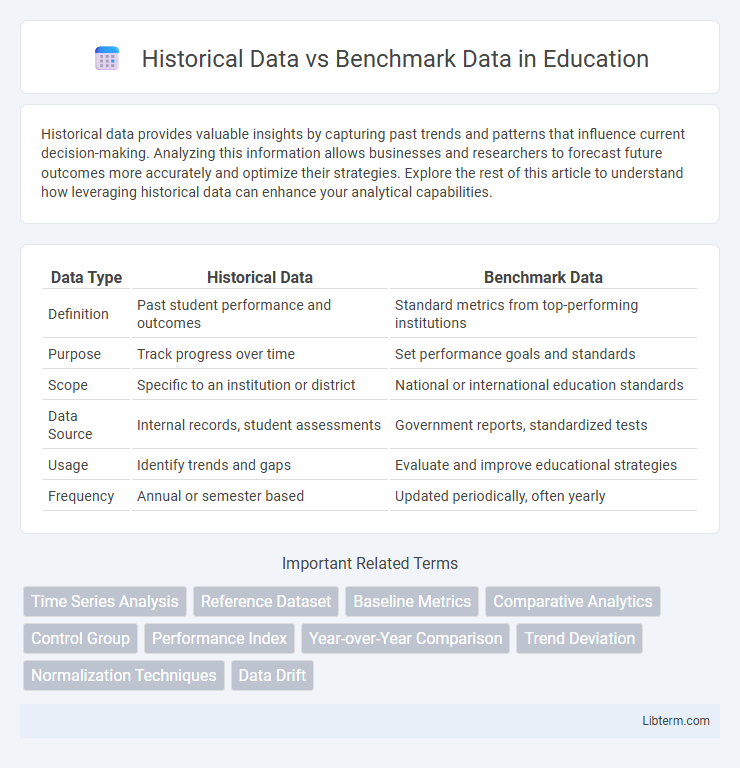Historical data provides valuable insights by capturing past trends and patterns that influence current decision-making. Analyzing this information allows businesses and researchers to forecast future outcomes more accurately and optimize their strategies. Explore the rest of this article to understand how leveraging historical data can enhance your analytical capabilities.
Table of Comparison
| Data Type | Historical Data | Benchmark Data |
|---|---|---|
| Definition | Past student performance and outcomes | Standard metrics from top-performing institutions |
| Purpose | Track progress over time | Set performance goals and standards |
| Scope | Specific to an institution or district | National or international education standards |
| Data Source | Internal records, student assessments | Government reports, standardized tests |
| Usage | Identify trends and gaps | Evaluate and improve educational strategies |
| Frequency | Annual or semester based | Updated periodically, often yearly |
Understanding Historical Data
Historical data represents past records and performance metrics collected over time, enabling trend analysis and forecasting accuracy in various industries. It provides context by capturing real-world outcomes, which helps businesses identify patterns, seasonality, and anomalies within their operations. Leveraging historical data supports informed decision-making and risk assessment by offering a reliable foundation for benchmarking and strategic planning.
Defining Benchmark Data
Benchmark data represents a set of reference points derived from industry standards, best practices, or leading competitors, enabling organizations to compare their performance effectively. Unlike historical data, which reflects an organization's past performance, benchmark data provides external metrics that guide goal setting and strategic improvements. Utilizing benchmark data allows companies to identify performance gaps and drive continuous operational enhancements through competitive analysis.
Key Differences Between Historical and Benchmark Data
Historical data represents past performance metrics collected over a specific time period, reflecting trends and patterns unique to an organization or process. Benchmark data serves as a standard or reference point derived from industry averages or best practices, enabling comparison against external performance criteria. The key difference lies in historical data's internal focus on prior results, while benchmark data provides external context for evaluating performance relative to peers or competitors.
Importance of Historical Data Analysis
Historical data analysis is crucial for identifying trends, patterns, and anomalies over time, enabling more accurate forecasting and strategic decision-making. Unlike benchmark data, which provides a comparative snapshot against industry standards, historical data offers a comprehensive view of past performance metrics specific to an organization. Leveraging historical data enhances risk management, optimizes operational efficiencies, and supports continuous improvement initiatives by grounding decisions in empirical evidence.
Role of Benchmark Data in Performance Measurement
Benchmark data serves as a critical reference point in performance measurement by providing standardized metrics derived from industry leaders or best practices, enabling organizations to gauge their own efficiency and effectiveness. Unlike historical data, which reflects an organization's past performance, benchmark data highlights gaps and opportunities for improvement by comparing current metrics to external standards. This comparative analysis drives strategic decision-making, fosters continuous improvement, and supports goal setting aligned with competitive realities.
Use Cases for Historical Data
Historical data is essential for trend analysis, forecasting, and identifying patterns over time, enabling businesses to make informed decisions based on past performance. It supports risk management by highlighting anomalies and seasonality that impact operational strategies in industries like finance and supply chain. Historical data also enhances machine learning models by providing extensive training datasets for predictive analytics and improving accuracy in customer behavior predictions.
Applications of Benchmark Data
Benchmark data is extensively applied in performance measurement, allowing organizations to compare their processes and outcomes against industry standards or best practices. It supports strategic planning by identifying gaps in efficiency and quality, guiding improvements through data-driven decision-making. In competitive analysis, benchmark data provides critical insights to evaluate market position, optimize resource allocation, and foster innovation.
Challenges in Using Historical vs Benchmark Data
Challenges in using historical data include issues with data quality, inconsistency, and relevance due to outdated or incomplete records, which can obscure current trends. Benchmark data poses challenges such as variability in industry standards, lack of context-specific details, and difficulties in ensuring comparability across different organizations or time periods. Both data types require careful validation and alignment to specific business objectives to provide meaningful insights.
Integrating Historical Data with Benchmarking Practices
Integrating historical data with benchmarking practices enhances decision-making by providing context through past performance trends and external industry standards. Combining internal historical metrics with external benchmark data enables organizations to identify performance gaps, set realistic goals, and drive continuous improvement. This synergy allows for more accurate root cause analysis and strategic planning by linking internal progress with competitive market dynamics.
Best Practices for Comparing Historical and Benchmark Data
Best practices for comparing historical data and benchmark data include ensuring data consistency by aligning time frames, metrics, and data sources to facilitate accurate comparisons. Employing normalization techniques helps adjust for external variables and market changes, enabling a more meaningful analysis of performance trends. Incorporating statistical tools to identify significant deviations highlights areas for improvement while maintaining context relevance and avoiding misleading conclusions.
Historical Data Infographic

 libterm.com
libterm.com